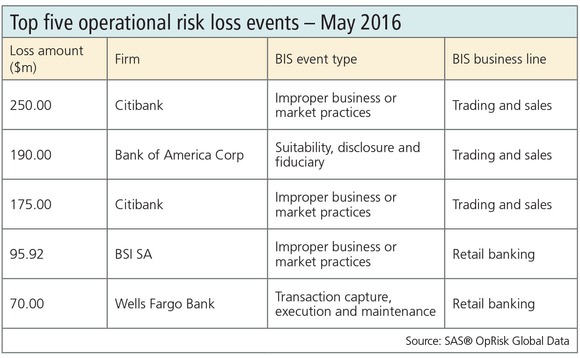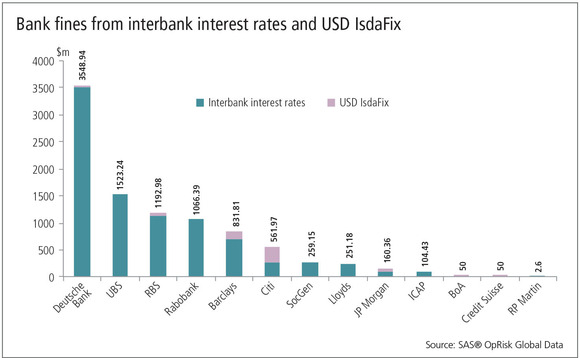
Benchmark misery will continue to plague banks
Index rigging caused $574 million of op risk losses in May, writes Megan van Ooyen from SAS

Megan van Ooyen is a senior associate business operations specialist in the OpRisk Global Data group at SAS in North Carolina

Benchmark manipulation losses dominated the news in May. As Citi can attest, banks continue to feel the sting for their role in manipulating interbank interest rates, years after the scandal first erupted. Such long-lasting effects do not bode well for the newest benchmark scandal – the impact of which has just begun to be felt by financial firms.
The Libor scandal started to unfold in earnest in June 2012, when Barclays admitted it had allowed interest rate derivatives traders to influence the submissions its treasury department made for Libor, the London interbank offered rate, and Euribor, the euro interbank offered rate.
Barclays’ settlement heralded an onslaught of joint agreements between banks and various regulatory agencies, including the US Department of Justice, the US Commodity Futures Trading Commission (CFTC) and the UK Financial Conduct Authority (FCA). Citi escaped the initial wave of settlements unscathed, but its reprieve was temporary. In 2010, the bank told the CFTC that it and two subsidiaries, Citigroup Global Markets Japan and Citibank Japan Ltd, had manipulated Libor and Tibor, the Tokyo interbank offered rate.
When the financial crisis broke in 2008, rising market instability led Citi to submit increasingly high dollar rates as part of its Libor submission. Somewhat ironically, executives worried the submissions would draw negative media attention: if the rate at which Citi could borrow was high, that meant the market considered it to have higher credit risk. So they ordered the bank’s treasury department to submit lower rates. At the same time, traders at Citigroup Global Markets Japan in Tokyo persuaded employees at Citibank Japan Ltd to submit favourable rates, instead of rates that reflected actual market conditions. The CFTC fined Citi $175 million in May for its actions. Judging from previous Libor settlements, there is a possibility Citi will have to answer to other regulators soon.
Although Libor refuses to relinquish the headlines, the new benchmark scandal du jour surrounds the US dollar IsdaFix – an index of benchmark rates for dollar interest rate swaps, which was originally set up by the International Swaps and Derivatives Association.
Prior to its reform in 2014, IsdaFix involved a panel of banks submitting swap spreads to London-based interdealer broker Icap every day at 11am New York time. Following the Libor scandal, suspicions soon arose about whether those spreads were accurate, and by early 2014 investors and regulators had begun pressing for more information. The floodgates opened in May 2015, when Barclays paid $115 million to the CFTC for manipulating dollar IsdaFix rates.
Libor has taught us that index-rigging cases are rarely one-bank operations, and it was only a matter of time until other firms found themselves nursing losses. In May this year, the dam burst, and banks handed over an additional $574 million in penalties and civil settlements. That included Citi, which received a $250 million civil penalty. The bank acknowledged its traders conspired to execute transactions in order to sway rate submissions one way or the other. Citi also admitted it intentionally submitted rates to Icap that favoured its own positions – not those it would have actually paid or received.
Not long after suspicions were originally raised about IsdaFix, a group of investors led by the Alaska Electrical Pension Fund filed a lawsuit against Icap and 13 panel banks. The investors accused the banks of using chat rooms and other methods to discuss the rates, before ‘banging the close’ – or rapidly executing trades just before the 11am fixing time in order to sway rates in their favour. After a failed attempt to get the lawsuit dismissed, Bank of America, Barclays, Citi, Credit Suisse, Deutsche Bank, JP Morgan and Royal Bank of Scotland (RBS) collectively agreed to settle for $324 million in early May. Icap and six other banks continue to dispute the allegations.

 Megan van Ooyen
Megan van Ooyen
Click here to enlarge, or tap image on app
To date, some financial firms have suffered more than $1 billion in losses due to lawsuits and regulatory penalties for index manipulation. So far, Deutsche Bank has taken the biggest hit, at $3.55 billion, followed by UBS ($1.52 billion), RBS ($1.19 billion), Rabobank ($1.07 billion) and Barclays ($832 million).
Despite this, the pain is not yet over. If the Libor fallout is any indication, you can expect IsdaFix manipulation penalties to plague banks for the next several years.
Only users who have a paid subscription or are part of a corporate subscription are able to print or copy content.
To access these options, along with all other subscription benefits, please contact info@risk.net or view our subscription options here: http://subscriptions.risk.net/subscribe
You are currently unable to print this content. Please contact info@risk.net to find out more.
You are currently unable to copy this content. Please contact info@risk.net to find out more.
Copyright Infopro Digital Limited. All rights reserved.
You may share this content using our article tools. Printing this content is for the sole use of the Authorised User (named subscriber), as outlined in our terms and conditions - https://www.infopro-insight.com/terms-conditions/insight-subscriptions/
If you would like to purchase additional rights please email info@risk.net
Copyright Infopro Digital Limited. All rights reserved.
You may share this content using our article tools. Copying this content is for the sole use of the Authorised User (named subscriber), as outlined in our terms and conditions - https://www.infopro-insight.com/terms-conditions/insight-subscriptions/
If you would like to purchase additional rights please email info@risk.net
More on Risk management
Op risk data: Tech glitch gives customers unlimited funds
Also: Payback for slow Paycheck Protection payouts; SEC hits out at AI washing. Data by ORX News
The American way: a stress-test substitute for Basel’s IRRBB?
Bankers divided over new CCAR scenario designed to bridge supervisory gap exposed by SVB failure
Industry warns CFTC against rushing to regulate AI for trading
Vote on workplan pulled amid calls to avoid duplicating rules from other regulatory agencies
Top 10 op risks: Change brings challenges as banks splash the cash
Higher interest margins and a trend toward insourcing drive major tech projects
Top 10 op risks: deepfakes drive rise in fraud fears
External fraud re-enters top 10 as artificial intelligence provides new tools for criminals
Should the ECB stress-test counterparty default risks?
The US Fed already does, but it is notable that EU banks were less exposed to Archegos
Top 10 op risks: third parties stoke cyber risk
High-profile hacks on market infrastructures and vendors expose linkage between top three risks
Beware war exclusions in cyber insurance, risk managers told
Risk Live: Experts say policy wording is tightening up following rise in ransomware attacks
Most read
- Top 10 operational risks for 2024
- The American way: a stress-test substitute for Basel’s IRRBB?
- Hidden Road ready for rush hour after FCM approval







